Generic structure potential of the english introductory information pages of university websites in Vietnam
University websites are an indispensible means for the purposes of information,
administration and promotion. In such a globalization era, university websites are designed
as a kind of multimodal text with the combination of language, signs, audio and visual
components, and presentation effects; and most websites are bilingual, trilingual, or even
multi-lingual, so as to address a variety of audience with different access purposes, of
different age groups, and from different countries and background. This paper reports on a
study of the generic structure potential (GSP) of the English introductory information pages
of 10 university websites in Vietnam. The GSP analysis is based on Hasan’s (1985)
framework. The aim of the analysis is to explore the obligatory, the optional, and the
iterative elements, which together construct the GSP of these websites. From the findings,
suggestions related to improving the quality and the functioning of the websites could then
be drawn out.
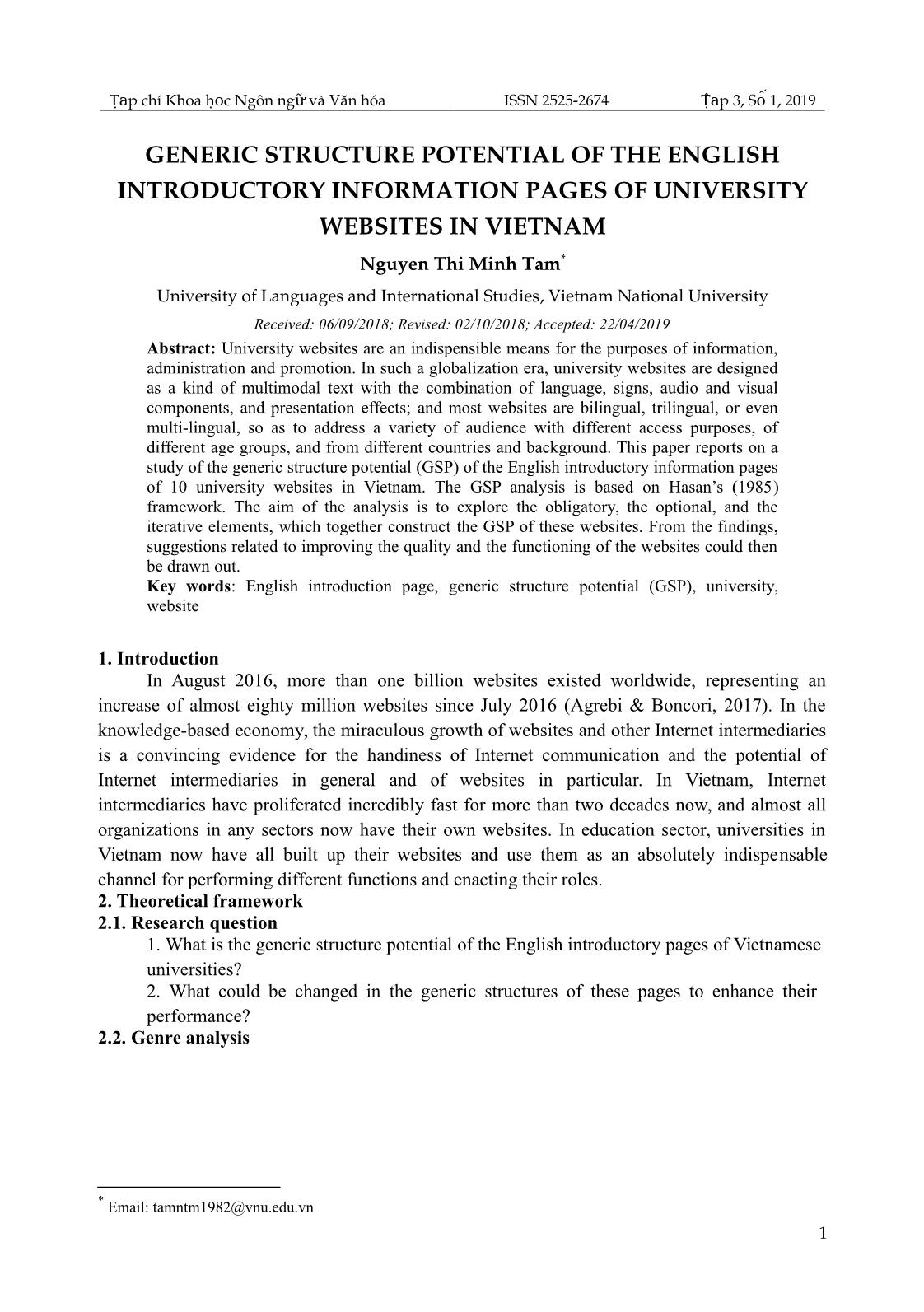
Trang 1
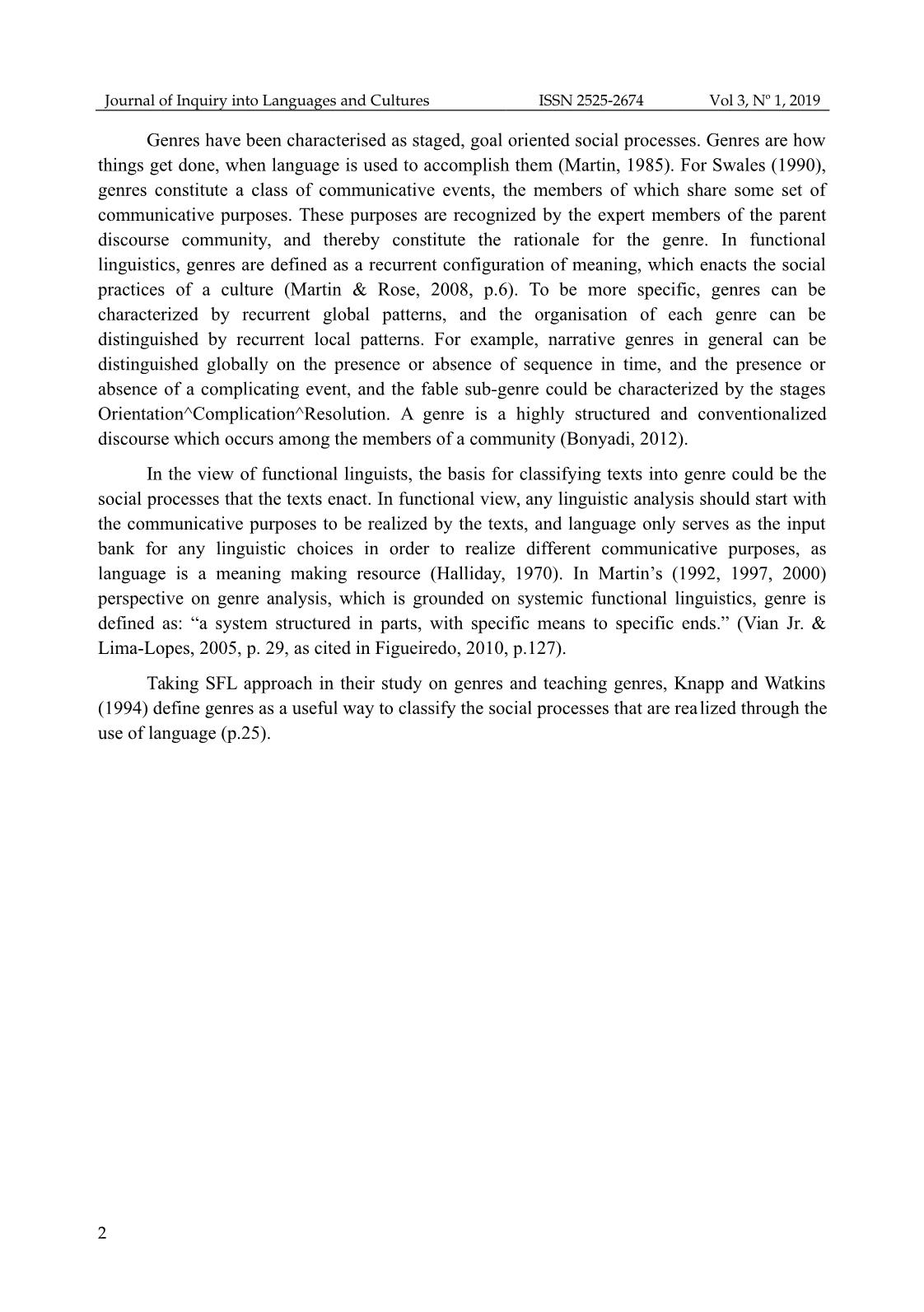
Trang 2
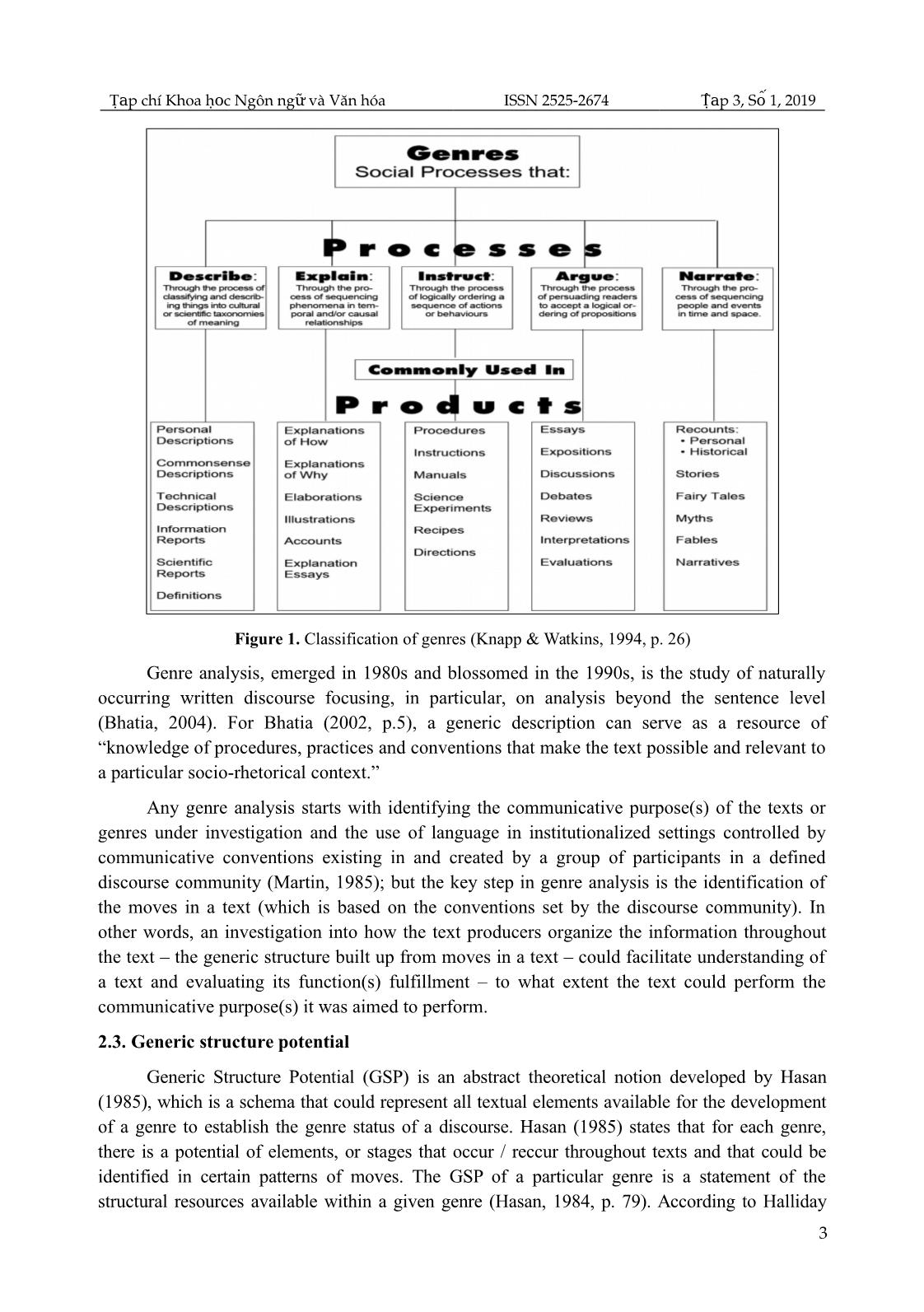
Trang 3
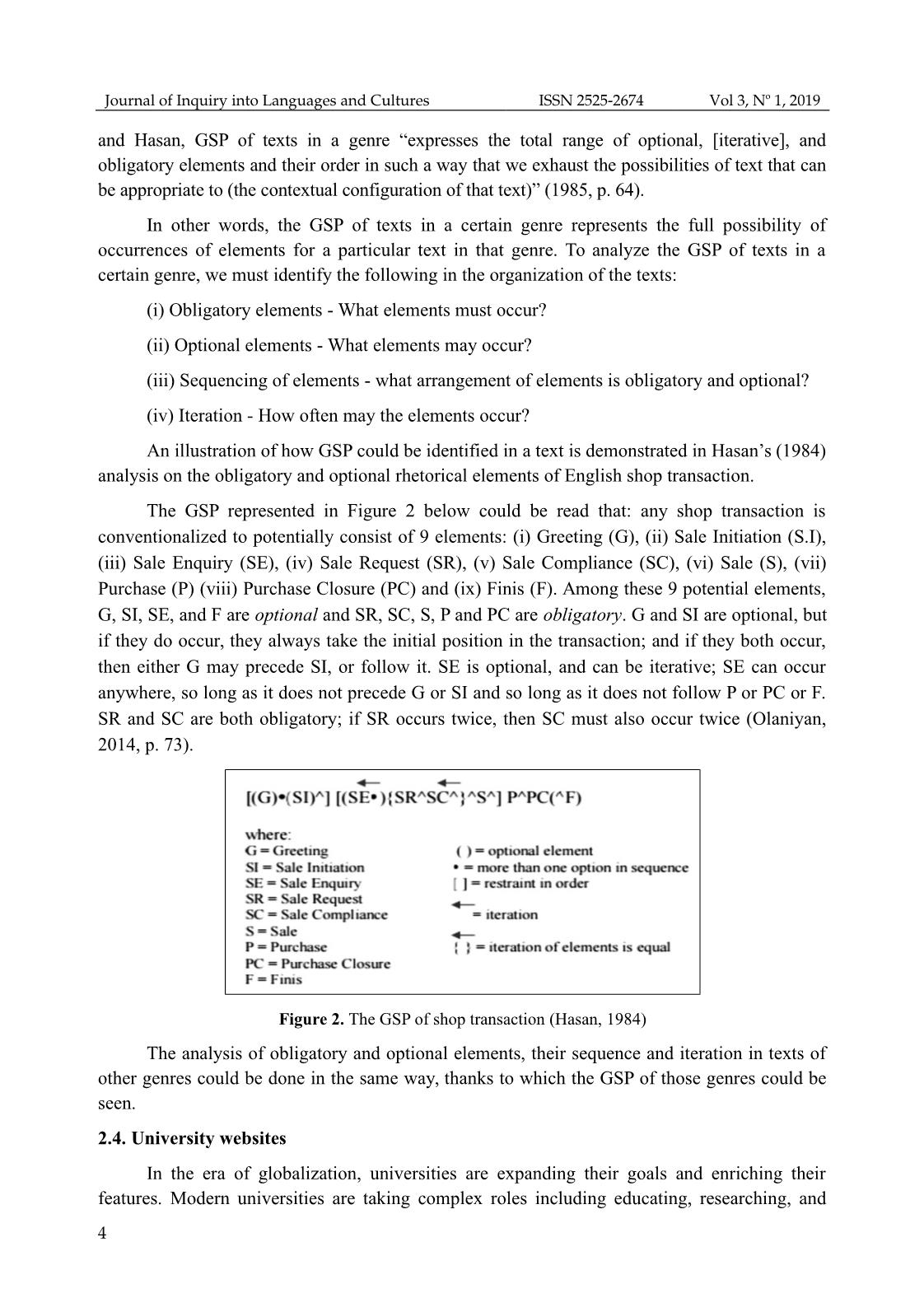
Trang 4
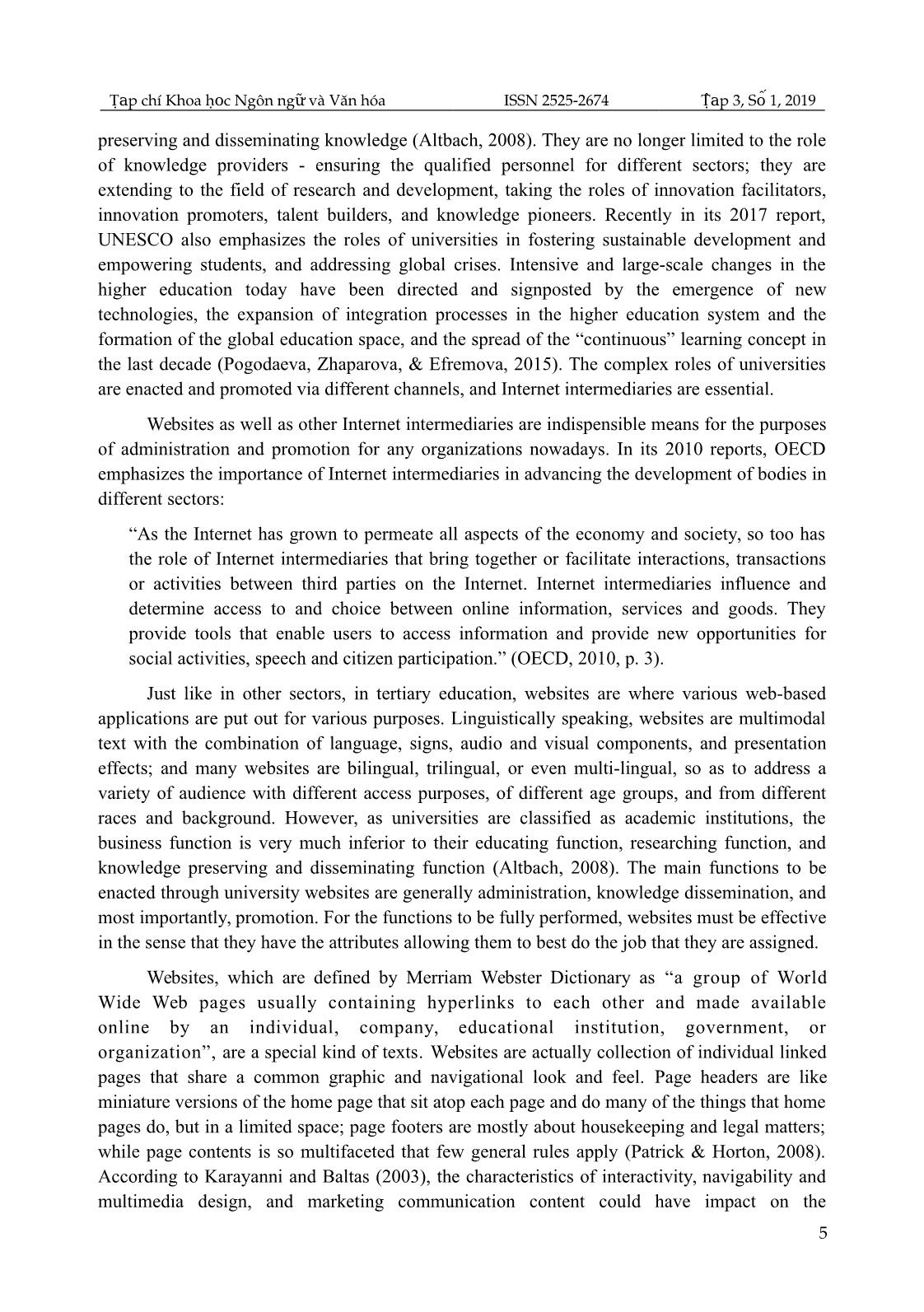
Trang 5
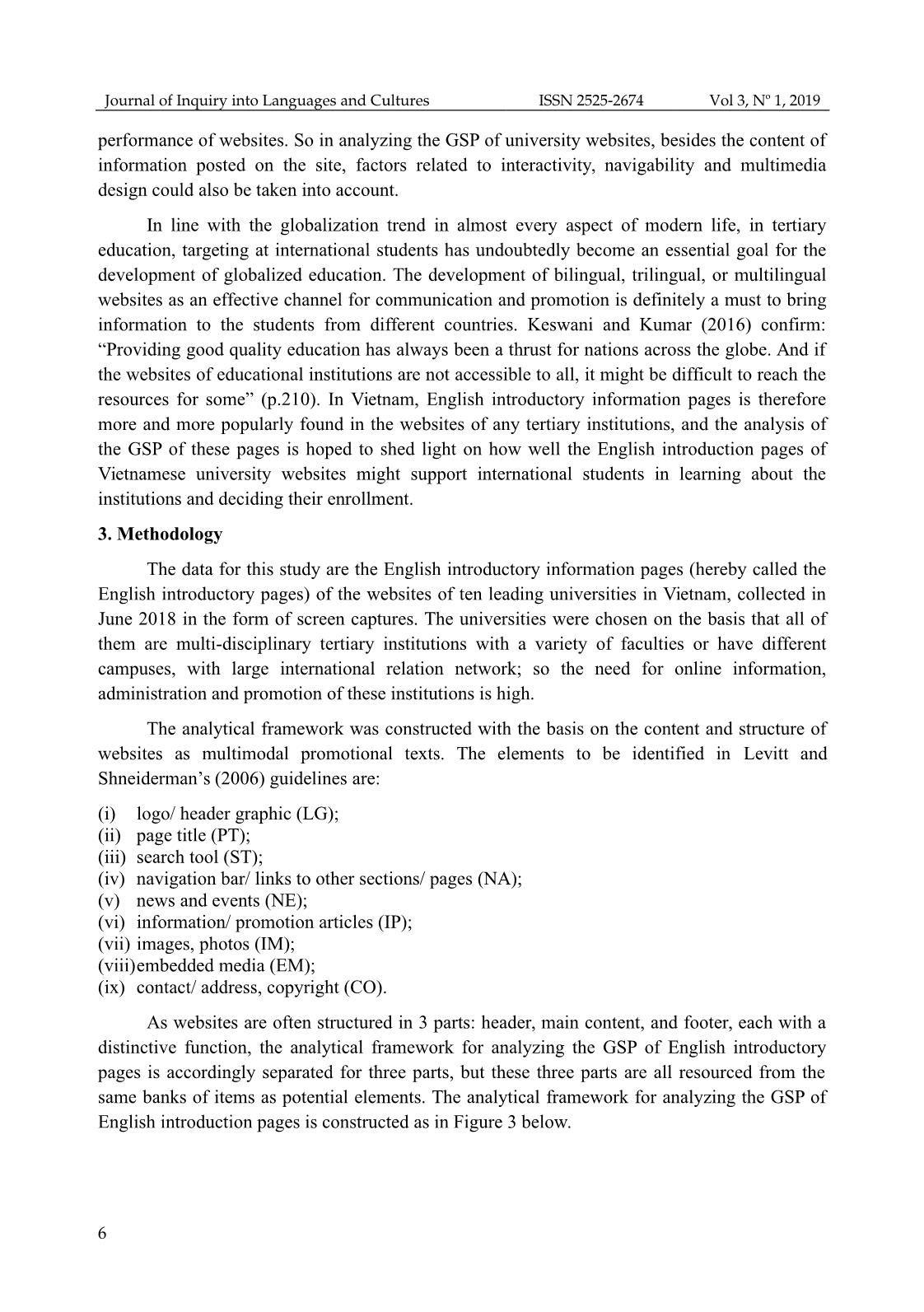
Trang 6
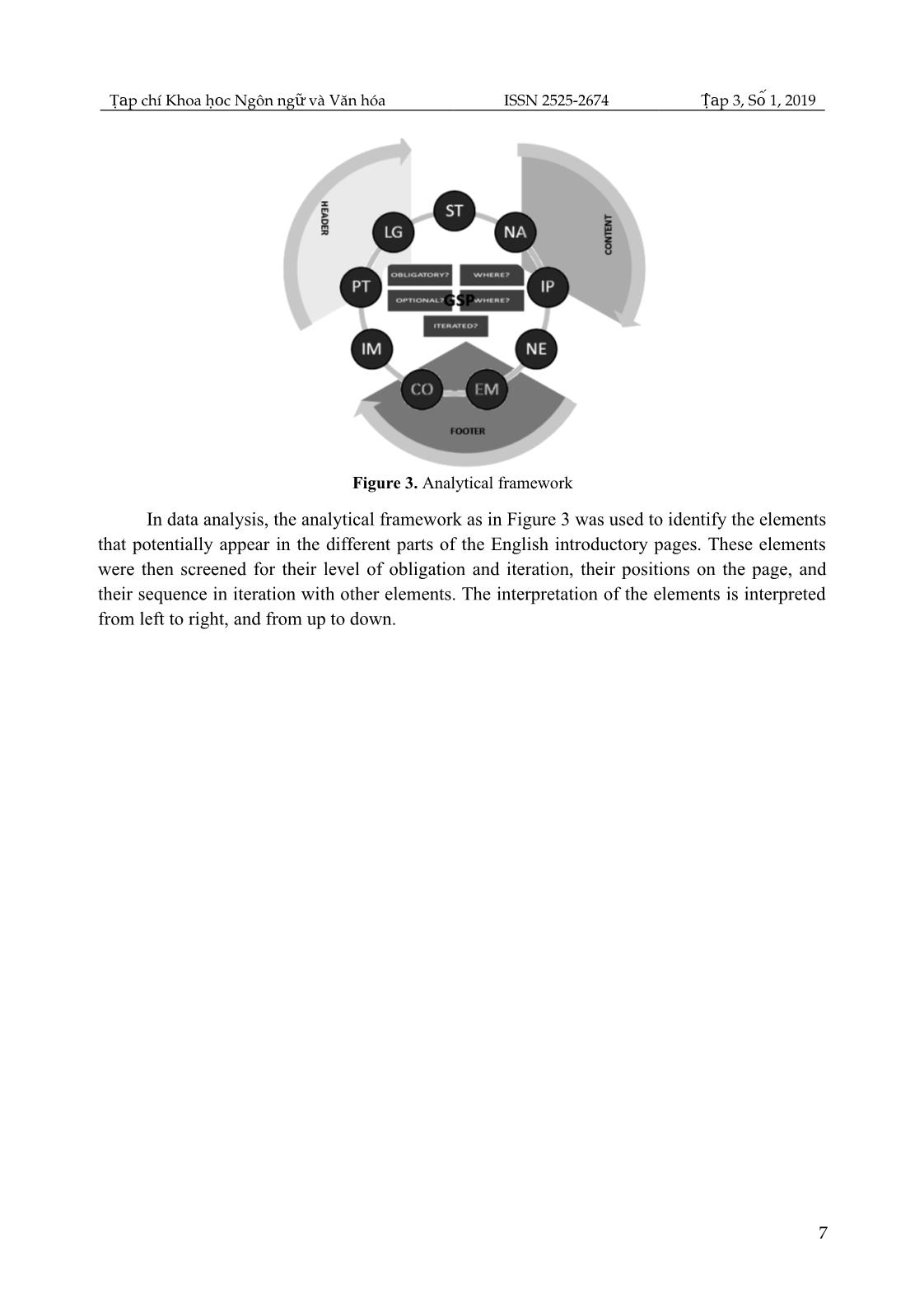
Trang 7
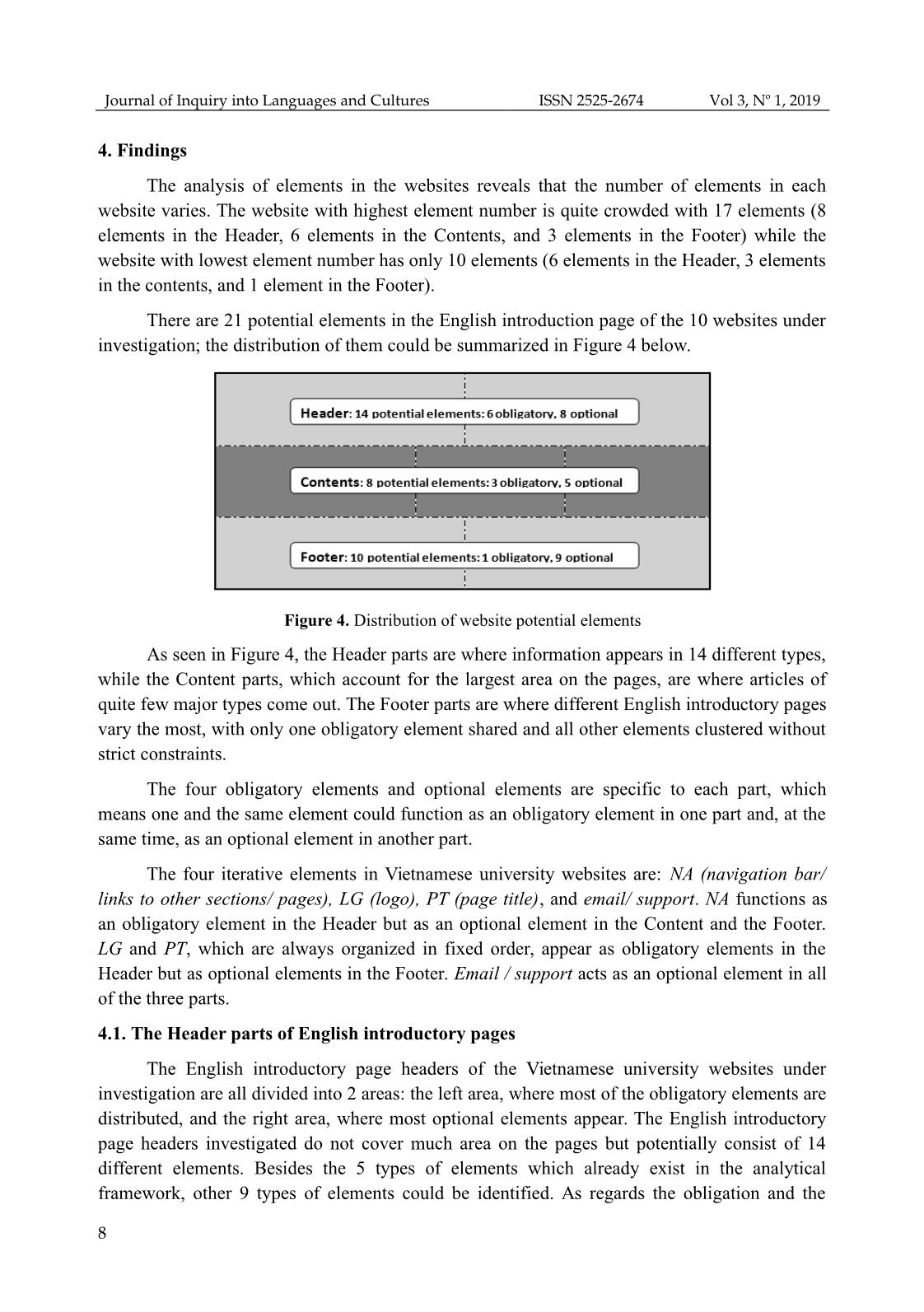
Trang 8
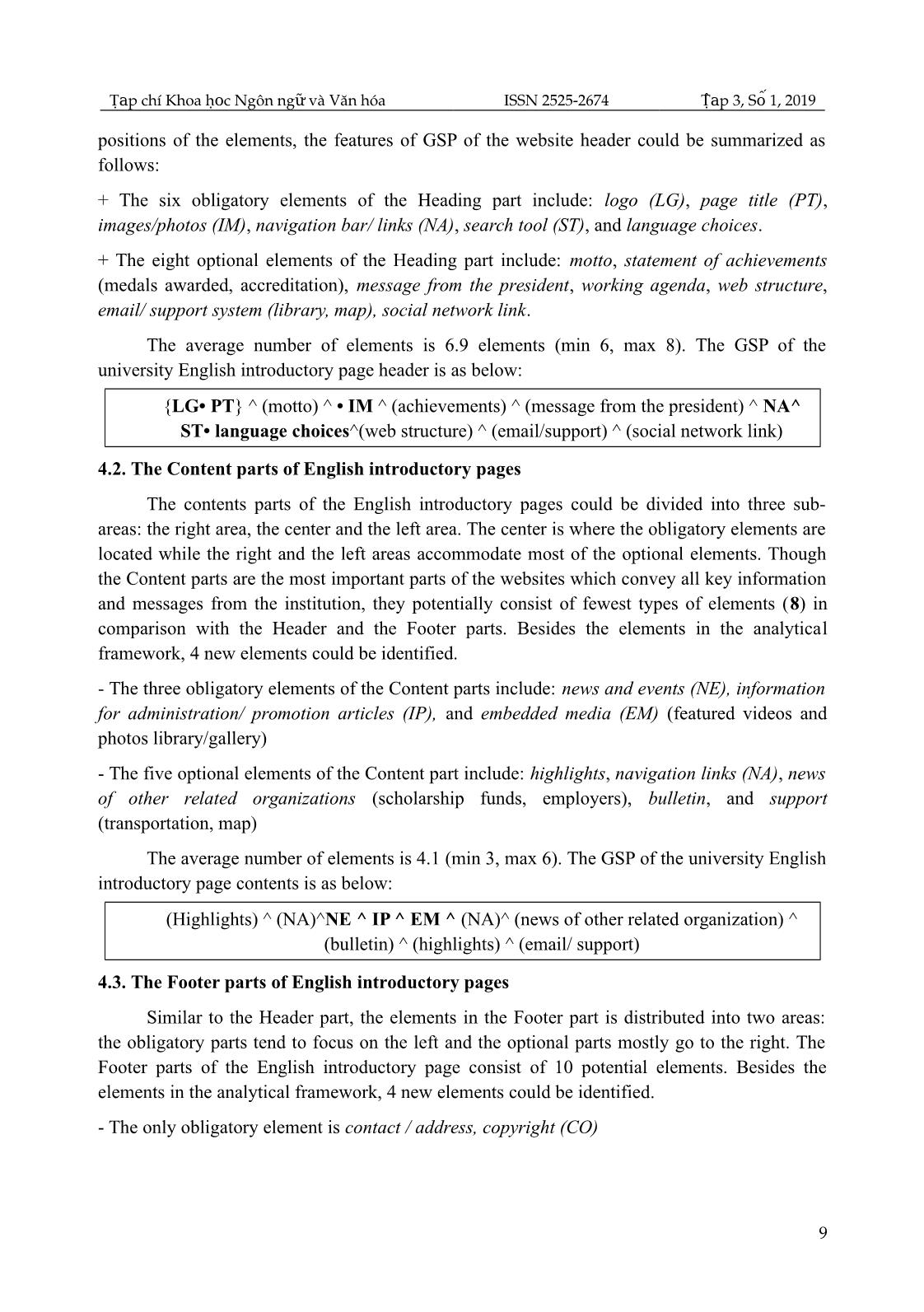
Trang 9
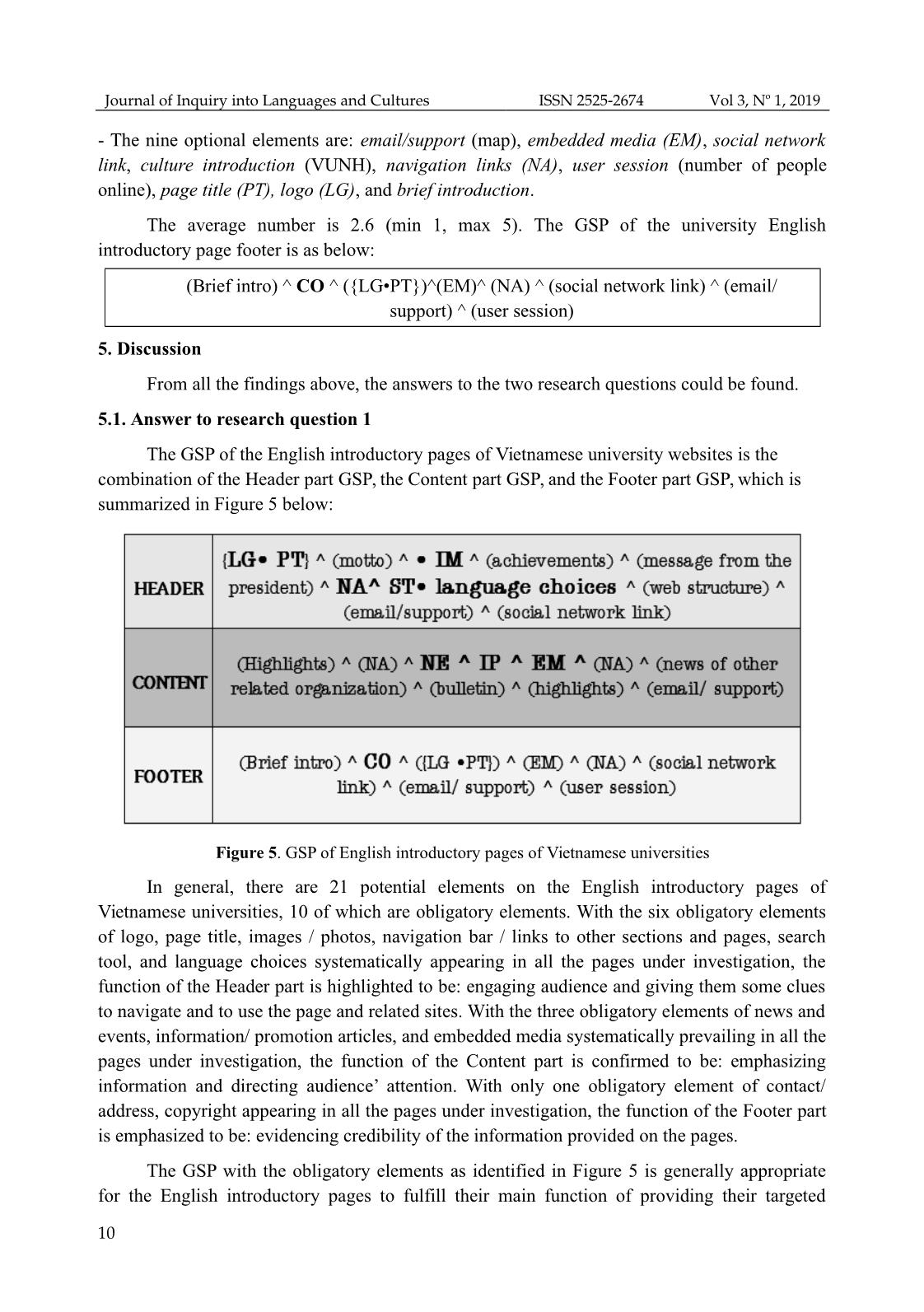
Trang 10
Tải về để xem bản đầy đủ
Tóm tắt nội dung tài liệu: Generic structure potential of the english introductory information pages of university websites in Vietnam
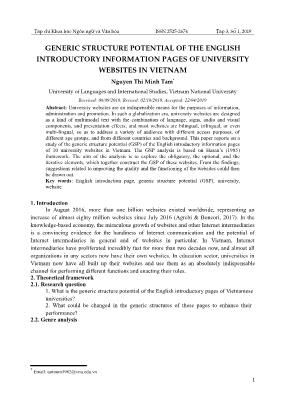
T p chí Khoa h c Ngôn ng và Văn hóaạ ọ ữ ISSN 25252674 T p 3, S 1, 2019ậ ố
GENERIC STRUCTURE POTENTIAL OF THE ENGLISH
INTRODUCTORY INFORMATION PAGES OF UNIVERSITY
WEBSITES IN VIETNAM
Nguyen Thi Minh Tam*
University of Languages and International Studies, Vietnam National University
Received: 06/09/2018; Revised: 02/10/2018; Accepted: 22/04/2019
Abstract: University websites are an indispensible means for the purposes of information,
administration and promotion. In such a globalization era, university websites are designed
as a kind of multimodal text with the combination of language, signs, audio and visual
components, and presentation effects; and most websites are bilingual, trilingual, or even
multi-lingual, so as to address a variety of audience with different access purposes, of
different age groups, and from different countries and background. This paper reports on a
study of the generic structure potential (GSP) of the English introductory information pages
of 10 university websites in Vietnam. The GSP analysis is based on Hasan’s (1985)
framework. The aim of the analysis is to explore the obligatory, the optional, and the
iterative elements, which together construct the GSP of these websites. From the findings,
suggestions related to improving the quality and the functioning of the websites could then
be drawn out.
Key words: English introduction page, generic structure potential (GSP), university,
website
1. Introduction
In August 2016, more than one billion websites existed worldwide, representing an
increase of almost eighty million websites since July 2016 (Agrebi & Boncori, 2017). In the
knowledge-based economy, the miraculous growth of websites and other Internet intermediaries
is a convincing evidence for the handiness of Internet communication and the potential of
Internet intermediaries in general and of websites in particular. In Vietnam, Internet
intermediaries have proliferated incredibly fast for more than two decades now, and almost all
organizations in any sectors now have their own websites. In education sector, universities in
Vietnam now have all built up their websites and use them as an absolutely indispensable
channel for performing different functions and enacting their roles.
2. Theoretical framework
2.1. Research question
1. What is the generic structure potential of the English introductory pages of Vietnamese
universities?
2. What could be changed in the generic structures of these pages to enhance their
performance?
2.2. Genre analysis
* Email: tamntm1982@vnu.edu.vn
1
Journal of Inquiry into Languages and Cultures ISSN 25252674 Vol 3, No 1, 2019
Genres have been characterised as staged, goal oriented social processes. Genres are how
things get done, when language is used to accomplish them (Martin, 1985). For Swales (1990),
genres constitute a class of communicative events, the members of which share some set of
communicative purposes. These purposes are recognized by the expert members of the parent
discourse community, and thereby constitute the rationale for the genre. In functional
linguistics, genres are defined as a recurrent configuration of meaning, which enacts the social
practices of a culture (Martin & Rose, 2008, p.6). To be more specific, genres can be
characterized by recurrent global patterns, and the organisation of each genre can be
distinguished by recurrent local patterns. For example, narrative genres in general can be
distinguished globally on the presence or absence of sequence in time, and the presence or
absence of a complicating event, and the fable sub-genre could be characterized by the stages
Orientation^Complication^Resolution. A genre is a highly structured and conventionalized
discourse which occurs among the members of a community (Bonyadi, 2012).
In the view of functional linguists, the basis for classifying texts into genre could be the
social processes that the texts enact. In functional view, any linguistic analysis should start with
the communicative purposes to be realized by the texts, and language only serves as the input
bank for any linguistic choices in order to realize different communicative purposes, as
language is a meaning making resource (Halliday, 1970). In Martin’s (1992, 1997, 2000)
perspective on genre analysis, which is grounded on systemic functional linguistics, genre is
defined as: “a system structured in parts, with specific means to specific ends.” (Vian Jr. &
Lima-Lopes, 2005, p. 29, as cited in Figueiredo, 2010, p.127).
Taking SFL approach in their study on genres and teaching genres, Knapp and Watkins
(1994) define genres as a useful way to classify the social processes that are realized through the
use of language (p.25).
2
T p chí Khoa h c Ngôn ng và Văn hóaạ ọ ữ ISSN 25252674 T p 3, S 1, 2019ậ ố
Figure 1. Classification of genres (Knapp & Watkins, 1994, p. 26)
Genre analysis, emerged in 1980s and blossomed in the 1990s, is the study of naturally
occurring written discourse focusing, in particular, on analysis beyond the sentence level
(Bhatia, 2004). For Bhatia (2002, p.5), a generic description can serve as a resource of
“knowledge of procedures, practices and conventions that make the text possible and relevant to
a particular socio-rhetorical context.”
Any genre analysis starts with identifying the communicative purpose(s) of the texts or
genres under investigation and the use of language in institutionalized settings controlled by
communicative conventions existing in and created by a group of participants in a defined
discourse community (Martin, 1985); but the key step in genre analysis is the identification of
the moves in a text (which is based on the conventions set by the discourse community). In
other words, an investigation into how the text producers organize the information throughout
the text – the generic structure built up from moves in a text – could facilitate understanding of
... her related organization) ^
(bulletin) ^ (highlights) ^ (email/ support)
4.3. The Footer parts of English introductory pages
Similar to the Header part, the elements in the Footer part is distributed into two areas:
the obligatory parts tend to focus on the left and the optional parts mostly go to the right. The
Footer parts of the English introductory page consist of 10 potential elements. Besides the
elements in the analytical framework, 4 new elements could be identified.
- The only obligatory element is contact / address, copyright (CO)
9
Journal of Inquiry into Languages and Cultures ISSN 25252674 Vol 3, No 1, 2019
- The nine optional elements are: email/support (map), embedded media (EM), social network
link, culture introduction (VUNH), navigation links (NA), user session (number of people
online), page title (PT), logo (LG), and brief introduction.
The average number is 2.6 (min 1, max 5). The GSP of the university English
introductory page footer is as below:
(Brief intro) ^ CO ^ ({LG•PT})^(EM)^ (NA) ^ (social network link) ^ (email/
support) ^ (user session)
5. Discussion
From all the findings above, the answers to the two research questions could be found.
5.1. Answer to research question 1
The GSP of the English introductory pages of Vietnamese university websites is the
combination of the Header part GSP, the Content part GSP, and the Footer part GSP, which is
summarized in Figure 5 below:
Figure 5. GSP of English introductory pages of Vietnamese universities
In general, there are 21 potential elements on the English introductory pages of
Vietnamese universities, 10 of which are obligatory elements. With the six obligatory elements
of logo, page title, images / photos, navigation bar / links to other sections and pages, search
tool, and language choices systematically appearing in all the pages under investigation, the
function of the Header part is highlighted to be: engaging audience and giving them some clues
to navigate and to use the page and related sites. With the three obligatory elements of news and
events, information/ promotion articles, and embedded media systematically prevailing in all the
pages under investigation, the function of the Content part is confirmed to be: emphasizing
information and directing audience’ attention. With only one obligatory element of contact/
address, copyright appearing in all the pages under investigation, the function of the Footer part
is emphasized to be: evidencing credibility of the information provided on the pages.
The GSP with the obligatory elements as identified in Figure 5 is generally appropriate
for the English introductory pages to fulfill their main function of providing their targeted
10
T p chí Khoa h c Ngôn ng và Văn hóaạ ọ ữ ISSN 25252674 T p 3, S 1, 2019ậ ố
audience, who are future international students (and possibly their parents) with core
information about the institutions. Such a GSP creates a consistent layout for the pages, which
in turn enhance the usability of the pages.
5.2. Answer to research question 2
Though the English introductory pages of Vietnamese universities generally succeed in
providing their targeted audience, who are future international students (and possibly their
parents) with core information about the institutions, there are still things that might be not quite
appropriate and could be improved.
Headers: On some pages, such as in Figure 6 there seem to be too many elements which
provide different details about the institution in the page headers. Besides the logos and the page
titles to provide the identity of the websites, photos/ images to engage the audience, the page
headers are perhaps characterized by the functions of navigation direction and support (with
search tool and language choices). The elements used for the functions other than the above
mentioned might be considered irrelevant.
Figure 6. A page header with many elements
As seen in Figure 6, the page header is quite crowded with 8 different elements namely:
logo, page title, medals achieved, navigation bar, working agenda, photos/images, email/
support, and language choices. What might be dropped out is the medals achieved, as this
element convey no plausible information to the international audience. The appearance of the
medals might be evidence that the website owner is not so clear about the targeted audience of
this English introductory page. With the targeted audience as future international students and
parents, who make no sense of what the medals mean; so there is no need to display them in the
limited space of the header. The images of leaders signing ceremonies and the AUN certificates
for accredited programs might be not interesting enough to run on the photo slide show, which
are aimed at engaging the young audience, who are more interested in learning about campus
life and future friends. The presentation on the page header illustrated in Figure 7 could better
attract future students.
11
Journal of Inquiry into Languages and Cultures ISSN 25252674 Vol 3, No 1, 2019
Figure 7. Header with appropriate number of elements
Contents: On some pages, for example in Figure 6, the contents are still very crowded
with texts of small font size, and the articles not categorized. Levitt and Shneiderman (2006,
p.50) point out that locating a target in a crowded area took longer than when the target was in a
sparse area. Targets in sparse areas of the display tended to be searched earlier and found faster
than in crowded areas.
Figure 8. Crowded contents part with uncategorized articles
As seen in Figure 7, the articles are not categorized into subgroups but listed in the order
of uploading time, making up a long range of news in different topics. In order to search for the
targeted piece of information, the audience read the latest news first, then scroll down and work
out what to read among many articles in the list. However, critical content and navigation
options are suggested to be towards the top of the page, visible with no, or a minimum of,
scrolling (Levitt & Shneiderman, 2006, p.47); so this way of arranging the contents of the page
is not considered a user-friendly way.
12
T p chí Khoa h c Ngôn ng và Văn hóaạ ọ ữ ISSN 25252674 T p 3, S 1, 2019ậ ố
Figure 9. Well-designed contents with categorized articles
In Figure 8, the contents of the page are organized according to the targeted audience
(also the name of each group) in an easy-to-navigate way. There is, thus, no need for audience to
scroll down and search, but quickly identify the articles readily grouped for them to access.
Footers: With the downmost position, the footers take the least important role in
providing key information to the audience. Instead, the page footers are for copy right statement
and support. The footers of the pages under investigation in this paper are quite appropriate in
terms of both functions and layout. Some universities are very creative in adding elements like
Vietnamese culture introduction (Figure 10) and even a brief introduction to the institution
(Figure 11) at the page footers.
Figure 10. Footer with shortcut to the article introducing the Vietnamese culture
In Figure 10, the shortcut to the article introducing the Vietnamese culture is a good offer
for the international audience who want to learn about the place they are planning to visit. In the
form of the shortcut, the element does not take much space.
Figure 11. Page footer with a brief introduction to the institution
13
Journal of Inquiry into Languages and Cultures ISSN 25252674 Vol 3, No 1, 2019
In Figure 11, the way of providing information about the universities in the form of
“About us” at the page footers is such a non-imposing way to introduce the institution to the
audience. The back-to-top button is also useful. As the footers are the place for supporting
information, other useful information might be added as well.
Figure 12. More supporting options on a page
As illustrated in Figure 12, the page footer could be employed for inspiring motto or
supporting direction of transportation means for future students.
6. Conclusion
In conclusion, the analysis on the GSP of the English introductory pages of Vietnamese
university websites, which could be further divided into headers, contents, and footers, reveals
that these pages are playing quite well their primary roles in administration, knowledge
dissemination, and most importantly, promotion. However, to better fulfill their functions, the
page headers and the page contents of some English introductory pages could be improved in
the sense that the elements which are too specific to Vietnam and irrelevant to the international
audience common knowledge should be omitted, the layout should not be too crowded and the
elements should be categorized in subgroups to enhance navigability of the sites. In the footers,
some additional supporting elements could be added.
References
Agrebi, M., & Boncori, A.L. (2017). What make a website relational? The expert view. European
Management Journal, 35, 617-631.
Altbach, P.G. (2008). The complex roles of universities in the period of globalization. In Global
university network for innovation (GUNI) (Ed.), Higher Education in the World. Vol.3. Higher
education: New challenges and emerging roles for humans and social development (pp. 5-14).
Palgrave MacMillan.
Bhatia, V.K. (2002). Applied genre analysis: a multi-perspective model. Ibérica, 4, 3-19.
Bhatia, V.K. (2004). Worlds of written discourse - a genre-based view. London and New York:
Continuum.
Bonyadi, A. (2012). Genre analysis of media texts. Procedia - Social and Behavioural Sciences, 66,
86-96.
Figueiredo, D. (2010). Context, Register and Genre: Implication for language education. Revista
Signó, 43(1), 119-141.
14
T p chí Khoa h c Ngôn ng và Văn hóaạ ọ ữ ISSN 25252674 T p 3, S 1, 2019ậ ố
Halliday, M.A.K. (1970). Language structure and language function. In J. Lyons (Ed.), New horizons
in linguistics (pp. 140-165). Penguin, Harmondsworth.
Halliday, M.A.K., & Hasan, R. (1985). Language, context and text: Aspects of language in a social-
semiotic perspective. Geelong: Deakin University Press.
Hasan, R. (1985). The structure of a text. In M.A.K. Halliday & R. Hasan (Eds.), Language, context,
and text: Aspects of language in a social-semiotic perspective (pp. 52-121). Geelong: Deakin
University Press.
Hasan, R. (1984). GSP Model of nursery tales. Nottingham Linguistic Circular, 13, 71-102.
Karayanni, D.A., & Baltas, G.A. (2003). Website characteristics and business performances: Some
evidence from international business-to-business organizations. Marketing Intelligence and Planning,
21(2), 105-114.
Knapp, P., & Watkin, M. (1994). Context-text-grammar: Teaching the genres and grammar of school
writing in infants and primary classrooms. NSW, Australia: Texts Production.
Kesswani, N., & Kumar, S. (2016). Accessibility analysis of websites of educational institutions.
Perspective in Science, 8, 201-212.
Levitt, M.O., & Shneideran, B. (2006). Research-based web design and usability guideline.
Washington DC: US Department of Health and Human Sciences.
Martin, J.R. (1992). English text: system and structure. Amsterdam: John Benjamins.
Martin, J.R. (1997). Analysing genre: Functional parameters. In F. Christie, & J.R. Martin (Eds.),
Genre and institutions (pp. 3-39). London: Continuum.
Martin, J.R. (2000). Design and practice: Enacting functional linguistics. Annual Review of Applied
Linguistics, 20, 116-26
Martin, J.R., & Rose, D. (2008). Genre relations: Mapping culture. London: Equinox
Martin, J.R. (1985). Process and text: Two aspects of human semiosis. In J.D. Benson & W.S. Greaves
(Eds.), Systemic Perspectives on Discourse Vol. 1 (pp. 248-274). Norwood, NJ: Ablex.
OECD (2010). The roles of internet intermediaries in advancing public policy objectives (Workshop
summary) (pp. 67-80). Paris, France.
Olaniyan, K.K. (2014). An exploration of the generic structures of problem statements in research
article abstracts. Research on Humanity and Social Sciences 15(4), 70-80.
Patrick, J.L., & Horton, S. (2008). Web style guide (3rd edition.). Kendallville, Indianna: Courier Inc.
Pogodaeva, T., Zhaparova, D., & Efremova, I. (2015). Changing role of the university in innovation
development: New challenges for Russian regions. Procedia – Social and Behavioral Sciences, 214,
359-367.
Swales, J.M. (1990). Genre analysis: English in academic and research settings. Cambridge:
Cambridge University Press.
UNESCO. (2017). UNESCO emphasizes the role of universities and higher education institutions in
fostering sustainable development and empowering learners. Retrieved on June 24, 2017 from:
unesco_emphasizes_the_role_of_universities_and_higher_educat.
15
Journal of Inquiry into Languages and Cultures ISSN 25252674 Vol 3, No 1, 2019
C U TRÚC TI M NĂNG TH LO I C A PH N GI I THI U Ấ Ề Ế Ạ Ủ Ầ Ớ Ệ
B NG TI NG ANH TRÊN CÁC TRANG THÔNG TIN Ằ Ế
TR NG Đ I H C VI T NAMƯỜ Ạ Ọ Ở Ệ
Tóm tắt: Với các trường đại học, trang thông tin giới thiệu (website) là kênh truyền thông
không thể thiếu. Để tăng hiệu quả quảng bá, công khai thông tin, đáp ứng yêu cầu toàn cầu
hóa trong phát triển học thuật, nhiều website được truyền tải qua nhiều dạng thức và ngôn
ngữ đa dạng để hỗ trợ việc tiếp cận thông tin tối đa từ nhiều đối tượng. Trong nghiên cứu
này, chúng tôi phân tích phần giới thiệu tổ chức bằng tiếng Anh trên các website trường đại
học dựa trên khung phân tích tiềm năng cấu trúc thể loại của Hasan (1985) trên ngữ liệu là
phần giới thiệu tiếng Anh trên website 10 trường đại học ở Việt Nam, từ đó đưa ra nhận
định về điểm hợp lý và điểm cần điều chỉnh để phần giới thiệu tiếng Anh này có hiệu quả
tốt hơn.
Từ khoá: Trang giới thiệu tiếng Anh, cấu trúc tiềm năng thể loại, đại học, trang thông tin
16
File đính kèm:
 generic_structure_potential_of_the_english_introductory_info.pdf
generic_structure_potential_of_the_english_introductory_info.pdf

